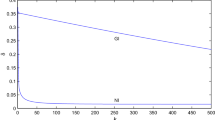Abstract
Based on the structural characteristics of the double-differenced normal equation, a new method was proposed to resolve the ambiguity float solution through a selection of parameter weights to construct an appropriate regularized matrix, and a singular decomposition method was used to generate regularization parameters. Numerical test results suggest that the regularized ambiguity float solution is more stable and reliable than the least-squares float solution. The mean square error matrix of the new method possesses a lower correlation than the variance-covariance matrix of the least-squares estimation. The size of the ambiguity search space is reduced and the search efficiency is improved. The success rate of the integer ambiguity searching process is improved significantly when the ambiguity resolution by using constraint equation method is used to determine the correct ambiguity integervector. The ambiguity resolution by using constraint equation method requires an initial input of the ambiguity float solution candidates which are obtained from the LAMBDA method in the new method. In addition, the observation time required to fix reliable integer ambiguities can be significantly reduced.
Similar content being viewed by others
References
Leick A. GPS satellite surveying [M]. New York: John Wiley & Sons Ltd., 1995.
Lachapelle G, Cannon M E, LU G. High precision GPS navigation with emphasis on carrier phase ambiguity resolution[J]. Marine Geodesy, 1992, 15(4): 253–269.
Hatch R. Instantaneous ambiguity resolution[C]. Kinematic systems in Geodesy, Surveying and Remote Sensing, IAG Symposia. New York: Spring Verlag, 1990: 299–308.
Hatch R, Sharpe T A. Computationally efficient ambiguity resolution technique[C]. Proceeding of ION GPS 2001. Salt Lake City: 2001: 11–14.
Frei E, Beutler G. Positioning based on the fast ambiguity function algorithm [J]. Journal of Geodesy, 1990, 15(4): 325–356.
Chen D, Lachapelle G A. Comparison of the FASF and least-square search algorithm for on the fly ambiguity resolution[J]. Journal of Institute of Navigation, 1995, 42(2): 371–390.
Teunissen P J G. The least-squares ambiguity decorrelation adjustment: a method for fast GPS integer ambiguity estimation[J]. Journal of Geodesy, 1995, 70(1): 56–82.
Mohamed A H, Schwarz K P. A simple and economical algorithm for GPS ambiguity resolution on the fly using a whitening filter [J]. Journal of Institute of Navigation, 1998, 45(3): 221–231.
REN Chao, OU Ji-kun, YUAN Yun-bin. A new method for GPS ambiguity resolution on-the-fly using integer whitening filter search[J]. Geomatics and Information Science of Wuhan University, 2004, 29(11): 960–963. (in Chinese)
OU J K, WANG Z J. An improved regularization method to resolve integer ambiguity in rapid positioning using single frequency GPS receivers[J]. Chinese Science Bulletin, 2004, 49(2): 196–200.
YANG Ren-gui, OU Ji-kun, WANG Zhen-jie, et al. Searching integer ambiguities in single frequency single epoch by genetic algorithm[J]. Geomatics and Information Science of Wuhan University, 2005, 30(3): 251–254, 259. (in Chinese)
YANG Ren-gui, OU Ji-kun. Method for improving success rate of phase integer ambiguity resolution of single frequency GPS receivers[J]. Journal of Nanjing University of Aeronautics & Astronautics, 2005, 37(3): 279–283. (in Chinese)
Teunissen P J G, Odijk D. Rank-defect integer estimation and phase-only modernized GPS ambiguity resolution[J]. Journal of Geodesy, 2003, 76(9–10): 523–535.
Han S, Rizos C. Single-epoch ambiguity resolution for real-time GPS attitude determination with the aid of one-dimensional optical fiber gyro[J]. GPS Solutions, 1999, 3(1): 5–12.
ZHOU Jiang-wen, OU Ji-kun, YANG Yuan-xi, et al. Research on the Theory of Observation Data and Errors[M]. Beijing: Seismic Publishing Press, 1999. (in Chinese)
Tikhonov A N, Arsenin V Y. Solutions of ill-posed problems[J]. New York: Wiley, 1977.
Yang Y, He H, Xu G, et al. Adaptively robust filtering for kinematic geodetic positioning[J]. Journal of Geodesy, 2001, 75(2–3): 109–116
Zhu J J, Ding X L, Chen Y Q. Maximum likelihood ambiguity resolution based on bayesian principle[J]. Journal of Geodesy, 2001, 75(4): 175–187.
Author information
Authors and Affiliations
Corresponding author
Additional information
Foundation item: Project (40474009 and 40204001) supported by the National Nature Science Foundation of China
Rights and permissions
About this article
Cite this article
Yang, Rg., Ou, Jk., Yuan, Yb. et al. Solving single-frequency phase ambiguity using parameter weights fitting and constrained equation ambiguity resolution methods. J Cent. South Univ. Technol. 13, 93–98 (2006). https://doi.org/10.1007/s11771-006-0113-6
Received:
Accepted:
Published:
Issue Date:
DOI: https://doi.org/10.1007/s11771-006-0113-6
Key words
- global position system
- ill-conditioned state
- parameter weight fitting method
- constraint equation
- integer ambiguity




